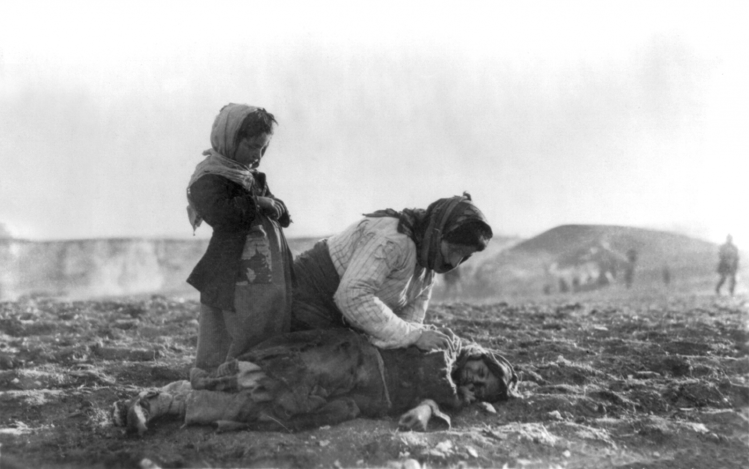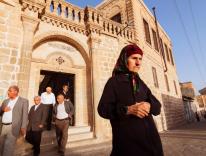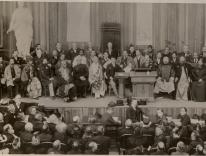
A traveler in Ottoman Turkey in the mid-nineteenth century would have discovered a robust and diverse Christian presence of different denominations and ethnicities, including Armenians, Greeks, and Assyrians. There were between 3 and 4 million Christians in what is now Turkey—around 20 percent of the total population. They were spread throughout the area, from Thrace in the northwest to the far-eastern regions of Anatolia beyond Lake Van, where Armenians likely outnumbered Turks. By 1924, through three successive waves of massacre, deportation, abduction, and forced conversion, Christians had been reduced to 2 percent of Turkey, and almost all who remained would depart in the following decades. The Thirty-Year Genocide tells the story of this religious cleansing.
The book’s authors, Benny Morris and Dror Ze’evi, argue, with meticulous detail, that the “thirty-year genocide” is not a story of Turk-versus-Armenian. It is a story of Muslim-versus-Christian. Documenting the atrocities committed against Christians by the Ottomans under Abdülhamid II (1894–96), under the “Young Turks,” or “Committee of Union and Progress” (CUP), between 1915 and ’16, and finally under the Kemalists between 1919 and ’24, the authors show again and again how Islamic rhetoric and Islamic authorities not only allowed but encouraged the elimination of Christian communities: “All of this occurred with the active participation of Muslim clerics and the encouragement of the Turkish press.”
The Qur’an teaches that “there is no compulsion in religion” (Q 2:256) and Islamic law affords Christians the right to practice (although not propagate) their religion in Islamic states. It would be wrong, then, simply to blame Islam for the genocide. Yet the authors show that, in attacks against Christians by Turks and other ethnic groups, “the overriding motivation was religious.” The text of the “Armenian Genocide” resolution passed in the U.S. Senate on December 12, 2019, recognizes the killing of “other Christians.” However, in line with recent scholarship—and the limited media attention the genocide has received—the resolution speaks only of an “Armenian” genocide. Morris and Ze’evi argue that this description fundamentally distorts history: “In recent decades historians have written well and persuasively about the Armenian Genocide of 1915–16. But what happened in Turkey over 1894–1924 was the mass murder and expulsion of the country’s Christians—Armenians, Greeks, and Assyrians.”
The Thirty-Year Genocide is well written, but it is not easy to read. In well over six hundred pages the authors detail, town by town and village by village, the atrocities that led to the elimination of Christians from Turkey. They begin by setting the scene in the 1870s and ’80s, when Armenians, aware of the spreading revolutions among majority-Christian states in the Balkans, and of the advance of Russian Tsarist forces over the Caucuses to the borders of eastern Anatolia, began to organize themselves within the Ottoman Empire. Some had ambitions for an independent Armenia. When Abdülhamid II became Ottoman Sultan in 1876, he responded to the rise of independence movements with a policy of intensified Islamization, and largely ignored the reforms demanded by the Berlin Congress of 1878. In the decades preceding the massacres of 1894–96 Christian villages were regularly subject to higher taxes (which could be avoided by converting to Islam) and to harassment by their Muslim neighbors (often Kurds). Occasionally Christian women were abducted, compelled to marry their kidnappers, and converted to Islam (a practice that still takes place in majority-Muslim countries including Pakistan and Egypt). Religious tensions were high and suspicion was in the air.
In 1894 Kurds began to attack Armenian villages including Yozgat, Sason, and Geligüzan, where they met Armenian resistance. Overwhelmed, a force of four hundred Armenian men surrendered on a mountain outside the town where, refusing to accept Islam, they were murdered in batches. Armenian women were abducted and boys were taken and sold into Muslim families. This pattern of murder, forced conversion of men, and abduction of women, spread like a wave through eastern Anatolia over the next two years. In one region, Mamuret-ül-Aziz, an Armenian bishop calculated that 15,179 people were forcibly converted to Islam, more than 5,530 girls raped, and 1,532 women and girls compelled to marry Muslims. Massacres of Armenians unfolded in and around the cities of Urfa and Diyarbekir, where masses of Christians converted to Islam to save their lives. In Urfa Turkish police officers circulated “axe in hand with their demand for the people to become” Muslims. The Western powers largely refused to intervene in the 1894–96 massacres, but Morris and Ze’evi note cases of Turks who sheltered and saved Armenians. (In the village of Çemişgezek, for example, a Turkish leader named Kemal Bey sheltered Armenians, to the anger of Kurds).
Twenty years later the Ottoman Empire was embroiled in the Great War and power had passed to the CUP. Russian forces were advancing on the eastern frontier and the CUP turned to the newly formed “Special Organization” (Teskilat-i Mahsusa) to implement a policy of deportation of Armenians to the Syrian desert. In town after town, first in the east and then in the west, Armenian elites would be arrested, men would be taken away to be executed or sent to labor squads, and the women, elderly, and children would be sent in convoys, or death marches, toward Aleppo and then Deir ez-Zor. From 1915 to 1916 upwards of one million Armenians were deported. Many died from exhaustion or from attacks by Kurdish and other civilians along the way. Armenians were eventually gathered in camps in the Syrian desert near Ras al-Ayn. Under the guidance of Salih Zaki, between 300 and 500 Armenians were taken out of the camp each day, killed (mostly by Circassian troops), and thrown into the Euphrates. As many as 350,000 Christians, mostly Armenians, were killed in the desert outside of Deir ez-Zor and Ras al-Ayn in these years. Those who made it to Syrian cities instead, including Aleppo and Damascus, lived in desperation. By one estimate, between 4,000 and 5,000 Armenian children had been sold to Arab families in Aleppo by 1918.
Those responsible for the policy of massive and brutal deportation justified it as a response to the Armenian “threat.” Cases of Armenian resistance or collaboration with Russia (for example at Van) were cited to prove the reality of this threat. But Armenians were not the only victims. In the ancient Christian cities of Nisibin and Cizre, and elsewhere, Muslim militias and civilians systematically executed men in the Assyrian Christian community and raped or abducted women and children.
The final wave of anti-Christian violence unfolded in the confusion of the post-war period in Turkey. The Ottomans had suffered defeat at the hands of the Great Powers, and Mustafa Kemal’s nationalists were establishing a new Turkish Republic in Ankara. In this period tens of thousands of Armenians returned to Cilicia, a region in the southwest occupied for several years by the British and French. The presence of the Allied powers, and the occupation of Smyrna and its environs by the Greeks, was met with violent resistance by Turkish nationalists. When the French and British eventually withdrew from Cilicia (and Istanbul) and the Greeks from Smyrna, horrible violence followed. Kemal placed the blame on the Christians: “Whatever has befallen the non-Muslim elements living in our country is the result of the policies of separatism they pursued in a savage manner.” By the time of the Treaty of Lausanne in July 1923 almost all the Armenians who had returned to Cilicia had been massacred, or fled again into exile. The Greeks of Smyrna had also been eliminated (many escaped on Allied ships to Greece), as had the ancient Pontic Greek community on the coast of the Black Sea, through a series of deportations and massacres (following a period of resistance—a point not emphasized by the authors). Kemal was glad to see the Christians gone: “The country has finally been returned to its rightful owners. The Armenians and the others have no rights at all here,” he told a Muslim audience in 1923.
The Nazis admired Kemal and Hitler saw the successful religious cleansing of Turkey as a model. “Who, after all, speaks today of the annihilation of the Armenians?” he famously said. Yet the Holocaust was of a different nature than the thirty-year genocide. The Nazis were not interested in the conversion of Jews. During the thirty-year genocide, by contrast, Muslims regularly demanded that Christians convert to Islam, and most of those who did were thus able to save themselves. Others who held onto their Christian faith still saved their children by giving them away to Turkish families. Similarly, in all three waves of the thirty-year genocide Christian girls and women were “saved” by being taken in massive numbers by Muslim men. (During the deportations of 1915, one Armenian reported seeing sixty wagons full of Turkish women, each of whom had five or six Armenian girls with her). They were given new Islamic names, forcibly converted, and kept as slaves or wives. As Morris and Ze’evi put it, “A Jew could not become Aryan, but an Armenian could become Muslim.” Tellingly Morris and Ze’evi did not find a single case of any Muslim punished for the abduction of women during this entire period. Thus, the recent enslavement of Yezidi and Christian women by ISIS in Iraq and Syria was not the return of a medieval practice. Christian women were being taken as wives and slaves on a larger scale only a hundred years earlier, and in the very same places.
Finally, it’s worth emphasizing that the co-conspirators and perpetrators of the thirty-year genocide were not all Turkish: Kurds, Circassians, Chechens, Arabs, and other Muslims also participated in the murders and abductions. And whereas the Holocaust was systematically carried out by the Nazi government itself, civilians of all sorts participated in the killing, theft, and abduction of Christians during the thirty-year genocide.
Morris and Ze’evi, Israeli academics from Ben Gurion University, are sensitive to all these distinctions between the two genocides. At the same time they note that “both the Nazis and the Turks benefitted from the docility of their victims.” The Christians of Turkey, and the Jews of Europe were simply unable to fight back; support from outside powers was too little, and came too late.
Nevertheless, there were moments of heroic intervention. In July 1915 a band of Armenian villagers took refuge on Musa Dagh (Mt. Moses), fighting off their attackers until they were rescued by a French fleet. The American consul in Aleppo, Jesse B. Jackson, mobilized his diplomatic corps to provide food and housing to Armenian refugees there. After the war, American Protestant missionaries—supported by the French and British—made enormous efforts to recover Armenian children who had been taken into Turkish and Arab homes and Islamized. King Faisal, the nominal Muslim Hashemite ruler in Damascus, ordered Arabs to return Armenians to “their people.”
The response of the Turkish state has not been heroic. Turkey has repeatedly refused to acknowledge the genocide, purged its archives of incriminating evidence, and pursued diplomatic retribution against those countries (including now the United States) that recognize the genocide. Still, Morris and Ze’evi could have added more nuance to the story of the genocide, which unfolded through three different regimes. The genocide was not one coordinated campaign of killing, but rather an epidemic of fanaticism, bigotry, and unchecked violence. Historical context also matters: the Ottoman Empire was falling apart, waves of Muslims were arriving in Turkey from the Balkans and Greece, and the great powers were interfering in Turkish affairs. Nothing can justify the genocide, but this context does complete the story.
Today the de-Christianization of the Middle East continues, accelerated recently by the brutal wars and terrorism in Syria and Iraq (along with economic migration and a low birthrate). Many Christians who were killed, abducted, or fled from ISIS and other Islamist militias between 2014 and 2016—notably Assyrians in places like Qamishli and the villages along the Khabur River in northeastern Syria—were the children or grandchildren of those Christians who had fled from Turkey during the thirty-year genocide.
As for Turkey, today there are almost no Christians left there (the last Armenian village, Vakıflı, has a population of 130). On the other hand, hundreds of thousands of Muslim Turks have at least one Armenian (or other Christian) ancestor. In 2018 President Erdoğan released records offering the genealogy of many Turks. Consequently, some Turks have indeed discovered and embraced their Armenian heritage. A few have even returned to the Christian faith of their ancestors, at significant personal risk.
The Thirty-Year Genocide is not a perfect book. Its treatment of the genocide of Assyrians (known in Syriac as the Seyfo) is incomplete. The book is nevertheless a monumental achievement. In its final pages Morris and Ze’evi express their hope that it might inspire more debate in Turkey. There are indeed a small but growing number of Turks who would like their government to recognize the thirty-year genocide and honor its victims, many of whom were their ancestors, or friends of their ancestors. Yet books like this are meaningful not only as calls to action. They are also meaningful simply because they are just. The blood of those killed calls out from the earth. Morris and Ze’evi have heard that call.
The Thirty-Year Genocide: Turkey’s Destruction of Its Christian Minorities
Benny Morris and Dror Ze’evi
Harvard University Press, $35, 672 pp.
Please email comments to [email protected] and join the conversation on our Facebook page.
Previous Story
Spiritual Resistance
Next Story
Police Brutality & Protest

